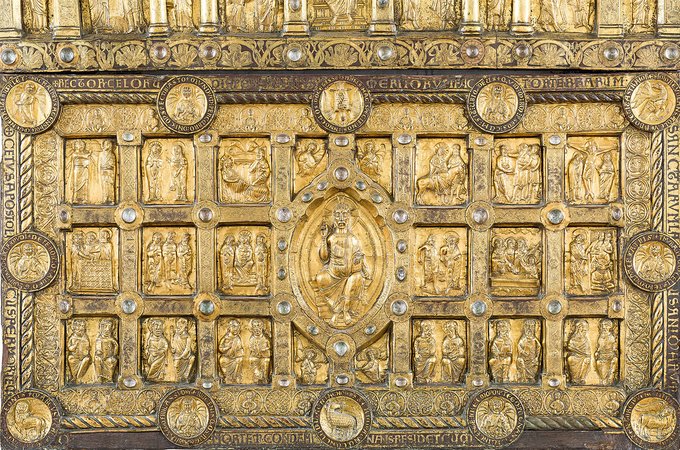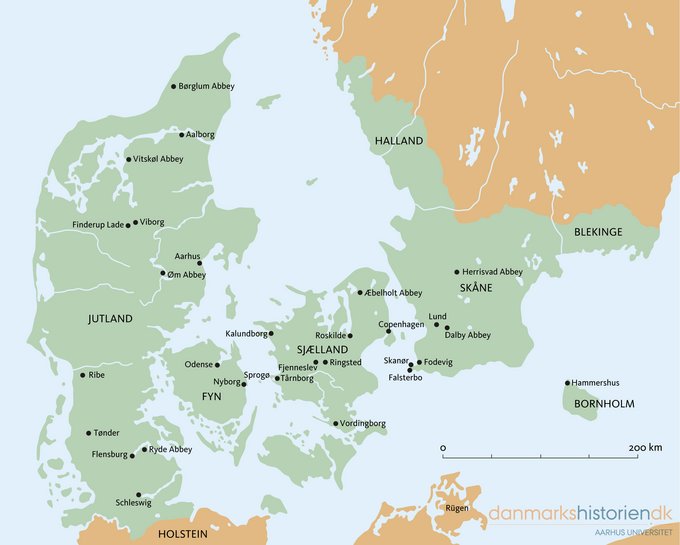1. Denmark as part of western Christendom
The era we know as the Middle Ages was shaped above all by the new faith, Christianity. This period is generally assumed to have begun around 500 in Europe, but in Danish history the ‘Middle Ages’ cover the years from the end of the Viking Age in around 1050 to the Reformation in 1536. From a European historical perspective, it could also be argued that the mid-eleventh century constitutes a natural turning point given the schism between the archbishop (the Patriarch) of Constantinople and the pope in Rome in 1054. The importance of this event should not be over-emphasised, but the years that followed saw the parallel development of the Orthodox Church in the east and the Roman Catholic Church in the west. The Roman Catholic Church, with the pope at its head, was united by shared doctrines and belief in the same god. Thanks to the position of Latin as a common written language for the elite, western Christendom could communicate internally. Written Latin facilitated close contact between the papal seat and Christian territories and kingdoms. Europe during the Middle Ages was thus in many ways more integrated and homogeneous than it had previously been.
The Golden Altar from Sahl Church in northwest Jutland, 1200–1225. The altar, which is decorated with gilded copper plates, portrays Christ, Mary and the apostles. The thousands of churches that were built in Denmark during the Middle Ages were splendidly decorated in God’s honour. Photo: Arnold Mikkelsen, National Museum of Denmark
The Danes became part of western or Latin Christendom in the eleventh century. The close connection between the pope in Rome and the secular German imperial power ceased in the middle of the century. Thereafter, and into the thirteenth century, the power of the papacy grew because, among other reasons, it could rely on the support of kingdoms outside the German imperial power, such as Denmark. Denmark only broke its ties with the papacy when the Reformation happened in 1536. This chapter ends in 1340, when the Danish kingdom was nearing extinction and the papacy was once again weakened.
The size of the Danish kingdom
The expanding yet unstable Danish kingdom of the Viking Age was replaced by a more consolidated form of governance from the middle of the eleventh century. This stability was intermittent, however. During the twelfth century the realm became fragmented. It was united under a sole ruler again from 1157, but from the end of the 1320s into the 1330s, the kingdom almost ceased to exist and was under foreign rule. Reunification of the Danish kingdom then began from 1340.
‘The land of the Danes is almost entirely divided into islands’, wrote the German chronicler Adam of Bremen in around 1075. In the words of Knýtlinga saga (The Saga of Knud’s Descendants), an Icelandic historical chronicle written in the thirteenth century, ‘Denmark is a large realm and is greatly dispersed’. Relatively early, however, the territory had a core, known as ‘the realm of the Danes’, or Denmark. This consisted of the Jutland peninsula as far south as the River Eider; Fyn, Sjælland and the smaller islands; and, east of the Øresund, the so-called Skåne provinces in present-day Sweden: Skåne, Halland, Blekinge and Bornholm.
Map of the Danish kingdom in the Middle Ages. The kingdom included Skåne, Halland and Blekinge and extended down to the River Eider in the south. It was only with the Dano–Swedish wars in the seventeenth century, when Denmark surrendered its eastern provinces, that the geography of the Danish kingdom radically changed. © danmarkshistorien.dk
The periphery of the Danish realm
Whereas Halland had been under Danish rule since the Viking Age, Bornholm and Blekinge only became part of the Danish kingdom during the eleventh and twelfth centuries. One text describes an aristocrat named Blood-Egil, who ruled on the island of Bornholm in the Baltic Sea at the end of the eleventh century. He ‘had a large group of warriors around him’ and ‘was always on war raids in the summer’. Egil gradually became too powerful and, after he looted a Norwegian merchant ship, the Danish king allegedly had him hanged and took over his territory. The Danish kingdom thus grew in the eleventh and twelfth centuries by gaining Blekinge and Bornholm, but the Blood-Egil episode is typical of the connection the peripheral regions had to the kingdom. A local ruler in these regions might gain power, only to lose it again to the Danish king. The power of the Danish king thus varied from region to region.
Royal power was weakened when the king’s sons and grandsons were given entire areas of the country as princely fiefs in the thirteenth century. Such areas included Lolland-Falster, Samsø, Blekinge, Nørre Halland and Sønderjylland (Southern Jutland). Halland, on the eastern side of the Kattegat, is an example of an area that was ruled as a princely fief throughout the thirteenth and fourteenth centuries. It was often divided into two parts, which were ruled separately.
Of particular significance was the allocation of separate status to one of the realm’s most important regions, namely the southern part of Jutland. The need for the presence of a royal representative to defend the border led to the emergence of a duchy during the thirteenth century, which became a separate entity between the Kingdom of Denmark to the north and the County of Holstein to the south. This new and eventually hereditary dukedom became known as Sønderjylland or Schleswig.
Danish territories outside the kingdom
During periods when royal power was greater, the Danish territory stretched far beyond the kingdom. Danish kings had ruled England during the Viking Age, and the dream of creating a Danish-English kingdom was fairly long-lived. The Danish king made two unsuccessful raids on England in 1069 and 1074/1075. In 1086 King Knud the Holy was murdered, partly as a result of his attempt to mobilise a Danish fleet to conquer England the year before. For long periods in the Viking Age, southern Norway was also under the rule of the Danish king. At the end of the twelfth century, the Danes were again deeply involved in Norwegian politics and attempted to win control of southern Norway.
At the end of the twelfth century there was further expansion along the southern shore of the Baltic Sea. From 1201, the Danish ‘empire’ included Holstein and Pomerania. Royal power expanded further across the River Elbe and created an ‘empire’ to the east that came to include parts of Estonia. This expanded realm then fell apart following a mighty battle at Bornhöved in Holstein in 1227, from which the Danish king had to flee. Only Rügen and the conquered parts of Estonia remained under Danish rule for a longer period.

